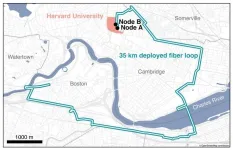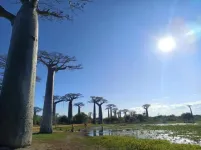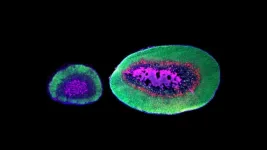(Press-News.org) Niels de Winter, affiliated with the Department of Earth Sciences at Vrije Universiteit Amsterdam and the AMGC research group at Vrije Universiteit Brussel, measured alongside colleagues from institutions such as the Institute for Natural Sciences in Brussels the chemical composition of fossil shells from Antwerp, Belgium. Those shells originate from molluscs such as oysters, cockles, and scallops found during the construction works of the Kieldrecht Lock. The molluscs lived lived during the Pliocene, approximately three million years ago, in the North Sea, which at that time also covered parts of Flanders and the Netherlands. The shells grew layer by layer, much like tree rings or fingernails, and stored very detailed information in their shell during their lifetime.
Snapshot of the seasons
During the Pliocene, the Earth was on average 2.5 to 3 degrees Celsius warmer than it is now. In their study, published in Science Advances, the researchers took a ‘snapshot’ of the climate at that time to gain insight into the difference between the seasons in a warmer climate.
Rare heavy isotopes
They use the ‘clumped isotope analysis’ method. With this method, researchers study the composition of shells in even more detail. They do this by measuring the extent to which rare heavy isotopes of both oxygen and carbon occur in the same carbonate from which shells are built. These isotopes are more common in shells that formed in colder waters. As a result, the measurements can be used to reconstruct the temperature in which the shells were formed. This method is more accurate than conventional methods for temperature reconstructions because it does not rely on assumptions about the composition of the seawater in which the mollusks grew.
Summers heat up more than winter
The key insight is that summers warm much more than winters in a warmer climate such as the Pliocene. While winters became about 2.5 degrees warmer, temperatures during summer were about 4.3 degrees higher. The researchers see a similar result in models projecting future climate, which predict roughly the same amount of warming for the year 2100.
The study gives us a glimpse of what the climate in Europe will be like if we continue our current trend towards a warmer world. De Winter: “We will likely experience stronger temperature differences between summer and winter, and the chance of heatwaves during the summer will increase.”
The publication is available here: https://www.science.org/doi/10.1126/sciadv.adl6717
END
Summers warm up faster than winters, fossil shells from Antwerp show
2024-05-15
ELSE PRESS RELEASES FROM THIS DATE:
Wearing face masks did not reduce risk of COVID infection after first Omicron wave, research shows
2024-05-15
After the first Omicron wave, research shows that many of the risks of Covid infection changed
Before February 2022, always wearing face masks and being retired were associated with reduced risk, but not after
Overseas travel was not associated with increased risk prior to February 2022, but then became a significant risk
Peer reviewed – meta-regression- humans
New research from the University of East Anglia has found that wearing face masks did not lower the risk of Covid infection following the initial surge of the Omicron variant.
The analysis of official data found that several risk ...
SF State receives $14M from the Genentech Foundation to support underrepresented students in STEM
2024-05-15
SAN FRANCISCO – May 15, 2024 – San Francisco State University announced today that it received $14 million from the Genentech Foundation to support two University programs that are training the next generation of life sciences leaders. The new five-year grant is the latest in the Genentech Foundation’s transformational support for University programs, which has totaled more than $33 million during their long-lasting partnership. This partnership has impacted more than 700 students since 2008, and an additional 350 students are projected to be supported by the new funding.
The new funds will continue sponsoring San Francisco State’s Genentech ...
Penalties for dropping out of ecosystem services incentive programs should equal lost environmental benefits
2024-05-15
Payment for Ecosystem Services programs (PES) are important tools that governments around the world use to improve water quality, protect forests and wildlife habitat, and sequester carbon. Under these programs, landowners - usually farmers - are paid to use their land in ways that protect or restore the environment, such as replacing row crops with trees or grassy zones adjacent to waterways. Many PES program contracts last 5 to 20 years, but participant drop out rates have consistently risen over the years.
A recent study by University of Maryland economists showed that PES programs ...
Lithuanian researchers’ new development in solar cell technology – a promise of a significant advancement in the field
2024-05-15
Researchers from Kaunas University of Technology (KTU), Lithuania, who contributed to the development of record-breaking solar cells a few years ago, expanded their invention. The self-assembled monolayers can now be applied not only in inverted but also in regular structure perovskite solar cells.
Self-assembling molecules arrange themselves into a single-molecule-thick layer and in this case, they act as an electron-transporting layer in solar cells.
“The molecules that make up these monolayers, like a clever glue, ...
A simple internet with significant possibilities
2024-05-15
It’s one thing to dream up a quantum internet that could send hacker-proof information around the world via photons superimposed in different quantum states. It’s quite another to physically show it’s possible.
That’s exactly what Harvard physicists have done, using existing Boston-area telecommunication fiber, in a demonstration of the world’s longest fiber distance between two quantum memory nodes to date. Think of it as a simple, closed internet between point A and B, carrying a signal encoded not by classical ...
Unwrapping the origin story of the baobab
2024-05-15
The baobab (Adansonia) is a genus of trees with eight extant (in existence currently) species and a long history of humans marveling at them. For as much admiration the baobabs get, there is an equal amount of mystery surrounding their origin.
Genomic and ecological analyses recently done by a global research team led by Sino-Africa Joint Research Center, CAS (hosted by Wuhan Botanical Garden of the Chinese Academy of Sciences), suggest that Madagascar, is the origin from where all other baobab species hail. With a deeper understanding of the baobabs' genetics, researchers are hoping to uncover some clues on what ...
The origin and long-distance travels of upside down trees
2024-05-15
The iconic baobabs, also known as upside-down trees, or the tree of life, have much cultural significance, inspiring innumerable arts, folklore, and traditions. A research published in Nature, involving international collaboration between Wuhan Botanical Garden (China), Royal Botanic Gardens (Kew, UK), University of Antananarivo (Madagascar) and Queen Mary University of London (UK) reveal a remarkable example of species radiation in Madagascar followed by long distance dispersal to Africa and Australia. With speciation, an astonishing divergence of pollination mechanisms evolved, that exploit hawkmoths, bats and lemurs for ...
Some mice may owe their monogamy to a newly evolved type of cell
2024-05-15
NEW YORK, NY — What makes the oldfield mouse steadfastly monogamous throughout its life while its closest rodent relatives are promiscuous? The answer may be a previously unknown hormone-generating cell, according to a new study published online today in Nature from scientists at Columbia's Zuckerman Institute.
"The hormone from these cells was actually first discovered in humans many decades ago, but nobody really knew what it did," said Andrés Bendesky, MD, PhD, a principal investigator at Columbia's Zuckerman Institute. "We’ve discovered ...
Mortality in patients hospitalized for COVID-19 vs influenza in fall-winter 2023-2024
2024-05-15
About The Study: This study found that in fall-winter 2023-2024, the risk of death in patients hospitalized for COVID-19 was greater than the risk of death in patients hospitalized for seasonal influenza.
Corresponding Author: To contact the corresponding author, Ziyad Al-Aly, M.D., email ziyad.alaly@va.gov.
To access the embargoed study: Visit our For The Media website at this link https://media.jamanetwork.com/
(doi:10.1001/jama.2024.7395)
Editor’s Note: Please see the article for additional information, including other authors, author contributions and affiliations, conflict of interest and financial disclosures, and funding and support.
# # ...
First ‘warm-blooded’ dinosaurs may have emerged 180 million years ago
2024-05-15
The ability to regulate body temperature, a trait all mammals and birds have today, may have evolved among some dinosaurs early in the Jurassic period about 180 million years ago, suggests a new study led by UCL and University of Vigo researchers.
In the early 20th century, dinosaurs were considered slow-moving, “cold-blooded” animals like modern-day reptiles, relying on heat from the sun to regulate their temperature. Newer discoveries indicate some dinosaur types were likely capable of generating their own body heat but when this adaptation occurred is unknown.
The new study, published in the journal Current Biology, looked at ...








